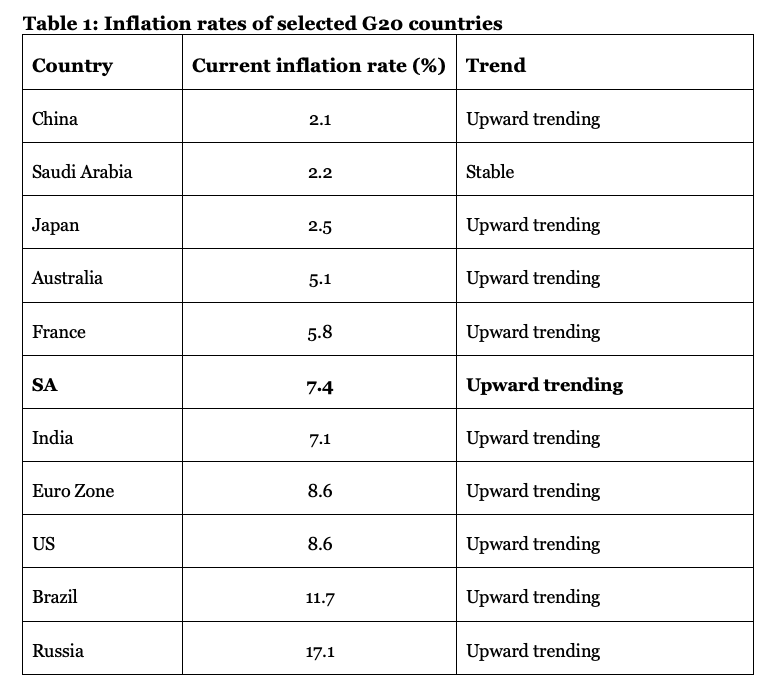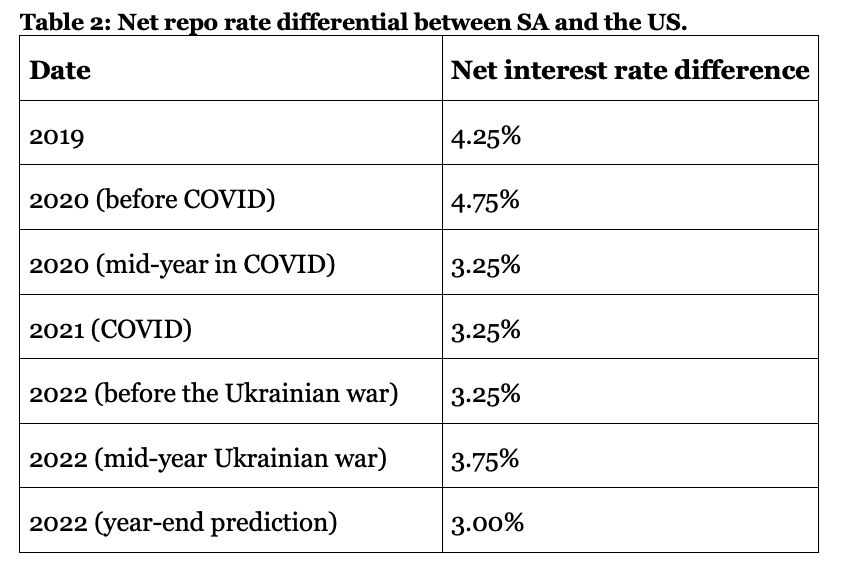The South African Reserve Bank (Sarb) implemented the inflation target policy in 2000. An inflation target band of 3% to 6% was selected, and this target was based on what the Sarb thought at that time was an appropriate level of inflation to allow economic growth.
The Sarb has successfully kept the inflation rate within the 3% to 6% band for most of the last two decades, but has been criticised for lack of flexibility in this process by seemingly neglecting other vital economic indicators. The central bank has conservatively and strictly maintained price stability, although the theory behind inflation targeting indicates that the target should be achieved in the medium term.
If inflation rises above the top band, policy implementation should attempt to lower inflation over the medium term to below 6%, considering other critical economic objectives.
The primary objective of the Sarb, in terms of Section 224 of the Constitution, is to “protect the value of the Rand, in the interest of balanced and sustainable economic growth in the Republic.”
The Sarb uses mainly interest rates as its monetary policy tool. The theory states that if the interest rate is increased, it could cause an inflow of capital, leading to an increased demand for the currency and appreciation of the rand. This is especially possible if the local interest rate ratio increases compared to major trade partners.
However, many factors determine the currency’s value, and the theory has been proven wrong in the past, meaning the Sarb policy actions sometimes have little impact. Economic growth is also a main objective of the Sarb. The question could be asked if the bank focuses enough on growth compared to price stability.
For example, in recent times, the Sarb has increased the repo rate even though economic growth was extremely low or even negative, with the inflation rate just above the top band of 6%.
The Sarb has also been criticised for seemingly not differentiating between demand-pull inflation, which is caused by demand pressure, versus cost-push inflation, which is caused by supply-side issues. Anti-inflationary policies should distinguish between the two types of inflation. Policies implemented in an inappropriate inflation environment could cause worse situations than inflation.
Table 1 below shows the contrasting outcomes of the five main economic objectives in South Africa since 2010. The Sarb has kept inflation within the target range since its inception compared to before this policy regime. The average inflation rate from 2010 to 2022 was 5.1%, well within the inflation target.
Low inflation usually relates to low economic growth. This is true in the South African environment, with an average economic growth rate since 2010 of only 1.35%, which is far too low to allow for job growth and improvement of quality of life in general. Economic growth rates of 3% or more are critically required over long periods.
It is expected that the Sarb will again increase the repo rate at its next meeting on 20 July 2023, even though the inflation rate is declining to close to the top of the target band and with low growth levels. This increase is due to an expected additional increase in the US repo rate by the Fed at its next meeting on 26 July 2023.
The question could be asked if the inflation target is still appropriate for a country desperately in need of high levels of growth. Growth of between 3% to 6% could not be achieved with an inflation rate below the mid-point of the current inflation target.
Other African countries such as Egypt, Ghana, Kenya, Nigeria and Zambia are examples of countries with higher inflation targets and also higher growth rates. In a recent econometric analysis by the author, taking into account historical inflation rates and growth rates, the “sweet spot” for economic growth would be an inflation target mid-point of 6%, not 4.5%.
The employment data also confirm the impact of low growth on the labour market. Unemployment has steadily increased to above 30%, and the employment-to-population ratio has decreased by 11% since 2010 from 45 to less than 40 in 2022. In 2022, the global employment-to-population ratio was approximately 55.8%, indicating that just over half of the global working-age population was employed. In SA, less than 40% of the working population is employed, indicating a dysfunctional labour market.
Gross fixed capital formation (GFCF) (also known as domestic investment) is one of the key drivers of economic growth, but the country has been experiencing an ongoing “investment strike”, with investment at only 14% of GDP in 2022. On a global scale, the average level of domestic investment as a percentage of GDP is between 20% to 25%, indicating our below-par investment, resulting in low growth.
As a result of the low growth environment, the income inequality index (Gini coefficient) has decreased to 63.0 in 2022. SA has the highest level of inequality in the world. The Gini index measures the extent to which the distribution of income or consumption among individuals or households within an economy deviates from a perfectly equal distribution.
A Gini index of 0 represents perfect equality, while an index of 100 implies perfect inequality. Only approximately 15 countries have a Gini Coefficient of more than 50, meaning high levels of inequality.

(Source: World Bank data.)
Considering the above issues, should we not have economic growth, employment and investment targets with inflation targets?
Inflation targeting has its pros and cons. The main advantage is that the inflation target is clear and quantifiable. The monetary policy is well-focused on achieving this target. But many disadvantages also are associated with this policy approach. It is based on a solid forecast outlook, an increasingly complicated process in a volatile economic environment.
Recent forecasts by the Sarb have been off target, impacting on the institution’s credibility. Ongoing adjustments of forecasts have occurred over the past decade.
Another problem is that the Central Bank could overreact to especially external shocks, such as during the Covid-19 years in 2020 and 2021 and the recovery years of 2022 and 2023, within a cost-push inflation environment with low economic growth. This policy implementation period caused damage to the growth possibilities and restricted growth in tandem with the impacts of load shedding.
Lastly, the Sarb’s monetary policy tool using the repo rate to control inflation does not work in some instances, such as rising wages, energy costs (fuel and electricity), and government spending.

(Source: Sarb data.)
Over the last few years, inflation has been driven by factors such as currency depreciation due to external and internal issues, supply chain problems, rising fuel and electricity prices, increases in local government services costs, rising production costs, and the costs to handle rolling blackouts.
The policy is not as effective in a cost-push inflation environment, and policy action in the current inflation environment should instead focus on reducing the role of the government in the economy and spending, improvement of supply and logistics infrastructure, limiting increases in energy costs and municipal services costs, and limit the level of wage increases. DM


















 Become an Insider
Become an Insider